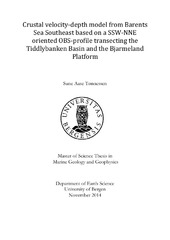Crustal velocity-depth model from Barents Sea Southeast based on a SSW-NNE oriented OBS-profile transecting the Tiddlybanken Basin and the Bjarmeland Platform
Master thesis
Permanent lenke
https://hdl.handle.net/1956/9204Utgivelsesdato
2014-11-20Metadata
Vis full innførselSamlinger
- Department of Earth Science [1050]
Sammendrag
A crustal model transecting the Tiddlybanken Basin, Hjalmar Johansen High and Bjarmeland Platform in the Barents Sea Southeast have been constructed with emphasis on P-wave phase picking and subsequent P-wave model-building with the ray-tracing software MacRay (Luetgert, 1992). The final model consist of a 7-8 km thick cover of platform sediments of Late Paleozoic - to Mesozoic age., underlain by a up to 11 km thick layer of Late Proterozoic age (Riphean Complex). The upper crystalline basement is situated at extreme depth of 13-16 km and is characterized by an irregular topography that can be divided into a basement high corresponding to Hjalmar Johansen High, and two basin-shaped depressions corresponding to Tiddlybanken Basin in the SSE of the profile and Bjarmeland Platform in the NNE of the profile. The crustal thickness is quite thin taken into consideration that the area is characterized as a platform area. The crust can be divided into an upper and a middle crust with the respective velocity-intervals of 6.15 - 6.35 km s^-1 and 6.5 - 6.7 km s^-1. The depth-position of the upper crust was poorly covered by arrivals due to the overprint over multiples from earlier arrivals; whereas the middle crust was characterized by high reflectivity and high amplitude arrivals. The Moho-discontinuity is situated at 32-34 km depth, and was covered by high-amplitude arrivals which could be picked at great offset-intervals.
